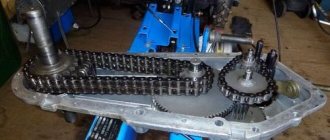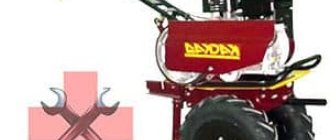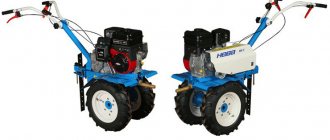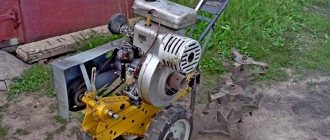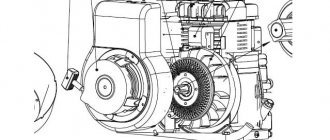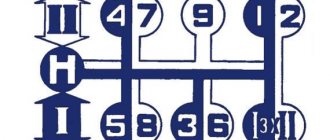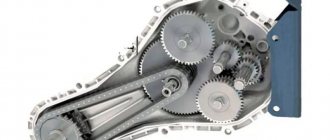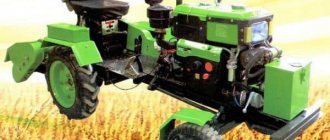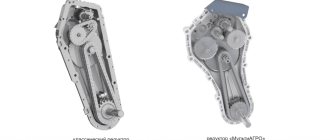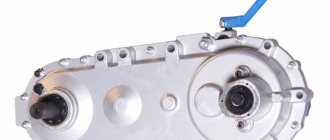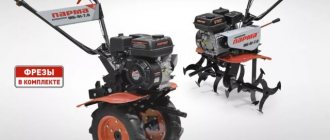Farming is a variety of agricultural work involving cultivating the soil, as well as caring for animals. This is a great way to provide your family with healthy and environmentally friendly products, as well as be able to sell vegetables and fruits and make money from it.
All farmers know how such work can be exhausting and even harmful to health. But we live in an age of technological progress, which means there is always special equipment on sale that makes the lot easier for everyone who owns large plots of land. Of course, such equipment will simply be unprofitable for those who have a garden of only about 2-3 acres, but those who own hectares simply cannot do without special machines.
In this article we will talk about the design of the gearbox - one of the main components of the Neva walk-behind tractor. About how to choose it and how to repair it if any malfunction is detected.
Gearbox for walk-behind tractor Neva
For modern gardeners, cultivating a plot of land is no longer as big a problem as it was in the recent past. Such universal equipment as walk-behind tractors has appeared on sale, which make life much easier for agronomists and gardeners.
Neva walk-behind tractors are one of the best units in their line. They are reliable, durable and multifunctional. You will be able to cultivate the land, care for plants, and collect and transport crops and garbage.
Here we will tell you about the gearbox for the Neva walk-behind tractor, its design and repair. This is one of the most significant elements in any car, so if you want it to last a long time and without breakdowns, you must know all the intricacies of its design, as well as the causes of malfunctions and methods for eliminating them.
Gearbox design on the Neva walk-behind tractor
The gearbox of the Neva walk-behind tractor is responsible for transmitting the rotation coming from the motor to the wheels and attachments. It controls the rotation number, speed, and direction - forward or backward. In principle, the gearbox for models MB 2 and MB 1 is not much different, so here we will consider the second option. The gearbox is designed in such a way that the components necessary for changing gears are located on its outer part of the housing.
The gearshift lever has 5 positions. When you push it, the fork disengages the clutch. When you drop the lever, the fork resumes its original position. The walk-behind tractor will pause when the drive is connected to the right axle shaft. Torque comes from the sprocket. When the handle is recessed, engaging the left sprocket, the gear is reduced. If you need top gear, the handle needs to be pulled out all the way.
Fuel consumption
Reviews from owners confirm that Luch MB 1 is highly economical and at the same time not demanding on fuel quality. In addition, it is noteworthy that the official data generally agree with the testimony of the owners. So, Luch MB 1 consumes an average of 1.5-2 liters per hour. This is a fairly low result, and therefore the developers decided to limit themselves to a modest 3.6-liter fuel tank.
The power unit in question is equipped with a forced air cooling system and an integrated manual starter. The lubrication system of a carburetor engine is carried out by splashing.
Gearbox malfunctions and repairs
Like any other equipment, walk-behind tractors can also fail. If the problem lies in the gearbox, you need to disassemble it and repair it. Often the breakdown turns out to be insignificant and you can easily deal with it yourself.
First, you need to thoroughly clean this part from dirt and residual oil, which will also need to be drained. All parts must be inspected and checked for damage. If something fails, it needs to be replaced. Use only new elements that are suitable specifically for your Neva walk-behind tractor model. Also, do not forget to add oil after assembly.
Some common gearbox failures:
- the spring or clamps are broken. They need to be replaced with new ones and then adjusted;
- The settings in the switching system have gone wrong. You need to loosen the screws, engage first gear, tighten the screws back;
- Oil is oozing through the shaft. Most likely the reason is the cuff, which is worn out. It needs to be replaced with a new one. How to replace oil seals? It is enough to remove the old ones by prying them off with a screwdriver or other object and install new ones;
- jamming appeared. This may be due to an open circuit. It needs to be replaced with a new one;
- you can't record the transfer. The reason is that the fork brush is worn out, so it needs to be replaced.
These are the main and most common gearbox failures. It is very important - if you cannot fix the breakdown yourself, then you should seek help from professionals.
Tools and materials
Regardless of the extent to which the walk-behind tractor is planned to be modernized, the following devices will be required for this work:
- welding machine;
- grinder with blades for cutting and grinding iron;
- electric drill;
- screwdriver;
- roulette;
- oil level;
- soldering iron;
- Screwdriver Set;
- core;
- hammer.
As a rule, all this is in the workshop of every owner of a summer house, country house or small farm.
To make an all-wheel drive tractor from a walk-behind tractor, you need to find or buy the following materials:
- steel angle 50 mm;
- sheet steel 3-4 mm thick;
- wires for lighting devices;
- wheels from a passenger car (2 or 4);
- solid hexagonal steel profile;
- iron wire 1 mm;
- seat with steel frame;
- headlight and side lights from a moped or motorcycle;
- generator or portable battery.
Most of this property can be found at a landfill or scrap metal collection point. Iron is given a presentable appearance by treating it with acid, a grinder and an anti-corrosion compound.
Do-it-yourself repair of the gearbox of the Neva MB 2 walk-behind tractor
Auto mechanic, specializes in agricultural equipment
Not so long ago, cultivating your plots using small-scale mechanization was problematic. This was due to a number of reasons: a small selection and the cost of goods, which hit the landowner’s pocket. Now the situation has changed dramatically. The market offers products from various companies from near and far abroad.
Moreover, the price of agricultural machinery is quite affordable. Reliable and multifunctional assistants have appeared - walk-behind tractors, which quickly and efficiently cultivate a plot of land: plowing, hilling, planting, mowing, as well as removing garbage and snow from the local area. All these and other operations are performed using attachments driven by the gearbox of the MB 2 walk-behind tractor.
The gearbox can be repaired with your own hands
If the device fails, the repair process is identical to other designs of walk-behind tractors. The most common malfunctions in the operation of mini tractors that you should pay attention to:
- when stopping the rotation of the crankshaft, it is necessary to unscrew the gearbox and carefully inspect the internal elements for damage;
- if white smoke comes out of the muffler, the reason is in the carburetor;
- the engine slows down and stalls - you need to wait until the engine cools down, then check the oil level and clean the cylinder head and the surface of the block from dirt.
Basic rules for using the mechanism will help you avoid costly repairs to the unit.
Repair instructions
In order to restore a faulty walk-behind tractor "Luch" MB 1, the repair instructions will definitely not be superfluous. By instruction we mean the same booklet that was supplied with all equipment produced in Russian factories.
But, as you know, without experience it’s quite difficult to figure out what’s broken, not to mention the design of the walk-behind tractor itself. But a person who is experienced in repeated repairs will be able to identify the problem without wasting time and also quickly fix it.
A good example of the level of knowledge and how well a person navigates a given walk-behind tractor is the reason why fire occurs from the exhaust pipe. The reason could be very simple - a defect associated with partitions in the muffler, which could burn out or simply fall off.
If the walk-behind tractors "Luch" MB 1, Cayman, Patriot, Texas, Foreman, Crosser, Viking, Forza do not start , then there may be more than enough reasons for the problem, starting from the presence of gasoline in the tank before it enters the carburetor, or if the belts are not in order or there are problems with their size...
In the first case, it is necessary to carry out simple manipulations: you need to fill the float chamber until the fuel begins to pour out from the hole in the lid. Or, check how gasoline flows by disconnecting the fuel hose from the carburetor.
A thin stream means that one of the filters is clogged - the fuel filter inside the tank, or the air filter in its lid. In this case, to restore operation it is enough to clean them, or, in extreme cases, replace them. But if you have any ignition problems, you should still check the spark plugs.
It needs to be unscrewed and inspected - if the spark plug is dry, it means the mixture is not getting into the cylinder. Otherwise, the problem is in the carburetor itself.
Ignition coil
The ignition coil of the Luch walk-behind tractor is an important part of the ignition system.
With its help, a low-voltage impulse, using the primary winding, is converted into a high-voltage one, which is supplied to the spark plug using a wire. Essentially, this is a sealed pulse step-up transformer, which, although manufactured using sophisticated technology, does not last forever.
there is no spark during the start , then there can only be one option - replacing the old coil with a new one, since it is not possible to repair it.
Carburetor
One of the vulnerable parts for which the Luch walk-behind tractor is known is the carburetor. It is best to repair a faulty carburetor after first familiarizing yourself with its diagram, since without disassembling the engine it will not be possible to even inspect it.
If you have already read all the necessary documentation and are ready to begin the actual repair, first you need to check whether everything is in order with it, as follows: after dismantling, you need to apply a stream of air through the fuel supply fitting when the part is in the working position.
A garden sprayer is an important and highly effective tool in the competent organization of work in the garden, allowing you to protect the plant, timely fertilize and carry out preventive maintenance. Here's how to make a sprayer with your own hands.
Snowmobiles are an indispensable form of personal transport in the northern regions. Yamaha snowmobiles - Japanese quality for harsh winters.
Those who sow lawn grass by hand know how difficult it is to achieve uniform seeding. By clicking on the link, you will become familiar with the different types of lawn seeders.
This operation must be repeated by turning the carburetor around and blowing into it from the other side. In the first case, the air should pass freely, in the second, it should not pass at all. If in both cases everything happens as described above, then the valve is working properly and fuel is flowing properly.
If air does not pass through, it means the carburetor is clogged and needs to be cleaned .
To do this, remove the cover over the fuel supply valve and pour cleaning agent into all channels. Having allowed it to cope with the contamination, the carburetor needs to be thoroughly cleared of dirt. Compressed air from a compressor is perfect for this.
Gearbox
Another cause of malfunctions is the gearbox of the Luch walk-behind tractor. Although most often it is the consumables that wear out, such as the gearbox seal of the Luch walk-behind tractor. It is replaced if a leak appears.
Running the gearbox dry, without oil, can lead to consequences in the form of rapid wear of the components - the gearbox will very quickly fail. The oil seal is replaced quite simply with a screwdriver; you just need to remove the cap and boot; there is no need to drain the oil.
Engine
The engine is the main unit of the walk-behind tractor , which most often needs repair.
It is with it that all the main difficulties associated with operation and work arise.
Repairing the engine of a walk-behind tractor Luch, Sadko, Don, Huter, Profi, Plowman, Champion with your own hands is quite possible, but it is still better not to start without prior preparation in the form of reading the instructions, especially if you have not done this before. In order to successfully repair the MB 1 “Luch” walk-behind tractor by disassembling the engine, the video will be very useful.
It will be possible to see all the nuances and details that cannot be taken into account in text format. In principle, engine repair, if the problem cannot be identified from the very beginning, can be entrusted to a specialist.
The need to replace the air filter for the MB 1 “Luch” walk-behind tractor arises if the engine does not develop power . As a result of prolonged operation, a lot of dust accumulates in it and a sufficient amount of air does not enter the carburetor.
Of course, you don't have to replace the filter every time problems like these arise. Simple cleaning is enough - if the contamination is not critical, you can simply remove the dust, but if there is a lot of dust inside, you will need to clean it with a vacuum cleaner.
The foam rubber will need to be thoroughly washed with detergent. After the filter’s service life expires, it loses its properties - then simple cleaning will no longer bring the expected effect, they will either need to be done more often or the filter must be replaced with a new one.
Milling cutters
Among all the attachments that are used on a walk-behind tractor, some may wear out faster due to the specifics of its use. These are the cutters for the Luch walk-behind tractor.
Due to the fact that they are installed instead of wheels, a lot of stress is created at the fastening points, as a result of which the fastening holes flare out over time.
As a result, play in the cutter occurs - the walk-behind tractor loses stability, which negatively affects the shaft, which can receive serious damage or become deformed.
To avoid this, it is necessary to constantly monitor the integrity of the cutter fastening device and its general condition. At the initial stages of deformation, the problem can be corrected using electric welding, gradually welding additional metal seams.
In the same case, if welding does not help and the cutters continue to become loose, the fasteners can be repaired by replacing them with similar homemade ones. Old fasteners should be cut off and new ones welded in their place.
Device by type of assembly
Depending on the ability to disassemble and repair the device, converters are divided into two types:
- A budget option in which inexpensive disposable parts are installed. If spare parts fail, it is better to replace the gearbox with a new one.
- Collapsible design allows you to easily replace a failed spare part. It can reliably serve for several years without breakdowns.
According to the type of gearbox design, there are the following:
This type of mechanism is equipped with a reverse motion of the walk-behind tractor.
Gearbox repairs and malfunctions
If the motor cultivator contains moving parts, then machine oil must be used. For high-quality operation of the mechanism, use only high-quality products and monitor the oil level. If repair work is necessary, all stages can be divided into:
- Drain the oil and clean the surface of the gearbox from contaminants.
- The case is disassembled and each element of the device is inspected.
- The necessary details change.
- Reassembly is performed with new lubricant being poured.
Tools and materials
Regardless of the extent to which the walk-behind tractor is planned to be modernized, the following devices will be required for this work:
- welding machine;
- grinder with blades for cutting and grinding iron;
- electric drill;
- screwdriver;
- roulette;
- oil level;
- soldering iron;
- Screwdriver Set;
- core;
- hammer.
As a rule, all this is in the workshop of every owner of a summer house, country house or small farm.
To make an all-wheel drive you need to find or buy the following materials:
- steel angle 50 mm;
- sheet steel 3-4 mm thick;
- wires for lighting devices;
- wheels from a passenger car (2 or 4);
- solid hexagonal steel profile;
- iron wire 1 mm;
- seat with steel frame;
- headlight and side lights from a moped or motorcycle;
- generator or portable battery.
Most of this property can be found at a landfill or scrap metal collection point. Iron is given a presentable appearance by treating it with acid, a grinder and an anti-corrosion compound.
Change of oil
The lubricant level indicates the need to replace it. If the time has come, then the procedure is performed as follows:
- To begin with, select a horizontal platform and place the Neva MB 2 walk-behind tractor on it.
- Find the engine oil plug on the engine and clean it and the surface nearby from all kinds of contaminants. The plug, which is also a dipstick, should be located in the lower part on the side.
- New oil is poured through the hole and the fluid level is checked using a dipstick.
Important! All work is carried out when the engine is cool, otherwise the oil level will be too high. The maximum mark must not be exceeded. This will increase the consumption of lubricating fluid, and the oil will begin to leak due to excess.
Replacing the oil seal
If oil leaks appear, this means it is time to change the oil seal. The work should be done as soon as possible, otherwise you may be left without a walk-behind tractor, because the movement of metal elements inside the device will lead to its destruction.
The sequence of operations is as follows:
- Remove attachments mounted on the output shaft.
- Clean the shaft and gearbox from dirt and debris.
- After unscrewing the fastening bolts, remove the cover.
- The old seal is replaced with a new one.
- The cover is installed in place and secured with bolts.
Gearbox of the Neva MB-2 walk-behind tractor: diagram and design, purpose and operating rules
The gearbox is an indispensable component of any equipment that uses an engine, since without it it is impossible to transmit rotational motion. Structurally, this element in the Neva-MB-2 walk-behind tractors is similar to parts used in other equipment, but to learn more about it, it is necessary to study the issue in more detail.
Peculiarities
The design of the walk-behind tractor is equipped with a gear-chain unit, the main task of which is to transmit rotational motion, and therefore to change the rotation speed of the cutters. It is thanks to the gearbox that the driven pulley transmits the mechanical action to the wheels of the equipment, thereby changing the speed and direction.
Inside the housing there is oil, which is necessary to ensure the operation of the gearbox. The element is enclosed in a durable sealed housing. Its kinematic scheme consists of a chain and two stars located in opposite directions. The lower one is called the driven one, because it stands on the shaft and drives the entire walk-behind tractor system.
Review of the Luch MB-1 walk-behind tractor: revealing the essence
Agricultural mechanization serves as the main direction of development of the agricultural policy of any state. For mechanized tillage, the Luch MB-1 walk-behind tractor is very popular.
The unit is a prominent representative of reliable and durable Soviet-made equipment. To perform various tasks, the unit is equipped with additional tools.
Description
Luch walk-behind tractors have come a long way from their creation to the present day. Initially, the manufacturer of these walk-behind tractors was the Perm Motors OJSC enterprise, which in the 90s became part of the Perm engine-building complex.
The units are well-deservedly popular among domestic farmers and have a reputation as powerful, productive, fault-resistant devices with varying capacities. Each owner can choose a walk-behind tractor model based on the site, scope of work, and purpose.
Photo of the Luch MB-1 walk-behind tractor
Features of the Luch walk-behind tractors are as follows:
- affordable price and high build quality;
- attachments suitable for many other domestic and Chinese models;
- endurance, possibility of use in any season;
- ability to work on any type of fuel (gasoline AI-92, AI-76, AI-82 and other types of gasoline);
- almost complete absence of bad reviews about walk-behind tractors (among the positive reviews there are many mentions of endurance, good assembly, reliability and power of the device).
: Review of the characteristics of the Lifan walk-behind tractor: we explain in detail
Manufacturers and production history of "Luch MB-1"
The first production model of the Soviet walk-behind tractor rolled off the assembly line of the Perm production association “Motorostroitel” named after Ya. M. Sverdlov” in 1985.
During the production of the walk-behind tractor, a large number of modifications of this equipment appeared. The main difference between each of them is the power plant and attachments produced by Russian and foreign manufacturers.
Since 1991, the unit has been produced by the joint-stock company Kaluga Engine (JSC CADVI). From 2011 to the present day, the equipment is produced under the name “Oka”.
Motoblock Luch MB-1
Design of the Luch MB-1 walk-behind tractor
The main components of the device are:
- Power unit.
- Gearbox.
- Clutch.
- Control system.
- Chassis.
Design of the Luch MB-1 walk-behind tractor
Clutch block
The system is designed to transfer rotation from the engine crankshaft to the gear sprockets. Allows you to move forward and backward. The clutch is controlled by a lever on the handle.
Motoblock clutch Luch MB-1
Control system
Designed to change the modes of action, speed and direction of movement of a mechanical device. Consists of a steering wheel, control levers and gear shift knob.
A motor control lever is installed on the right handle of the steering wheel. The left handle has gear shift levers. The steering wheel height is adjusted using a nut connection.
Walk-behind tractor control levers
Chassis
Wheels or a cultivator are installed as elements of the Luch MB-1 chassis. Wheels can be pneumatic or solid rubber. They are designed to move the mechanism on a flat surface. For better traction, stamped steel wheels (lugs) are used.
A cultivator is used to loosen the soil and remove weeds. The device is equipped with two tillers and two cultivators based on a bolted connection. Installed on the output shaft of the gearbox instead of wheels.
Milling cutter for walk-behind tractor
Available Luch models - engine types, power
The model range of Luch walk-behind tractors is represented by the following positions:
- Luch MB-1 (power 5 hp, Kadvi 168F-2A engine);
- Luch MB 5040 (a series of walk-behind tractors with engines DM51, 52, 53 and 54, had an easy start function and a forced lubrication system, the power of walk-behind tractors in this series was 5 hp, in fact 5040 was a more advanced version of MB-1);
- Luch MB 5141 (engine DM51, power 5 hp, a model that has not become popular, is now represented mainly by used models, new walk-behind tractors of this series are not produced).
Of all the indicated representatives of a number of walk-behind tractors, only the “Luch” MB-1 is produced for mass consumption.
The design features of the Luch walk-behind tractors are generally similar, the units are similar to each other, in different series the shape of the fuel tank can only change, for example, in the MB 5040 the tank is square, located closer to the engine.
Motoblock "Luch" MB 5040
Compound
The walk-behind tractor gearbox includes the following important parts:
- screws;
- bearings;
- axles;
- stars;
- frame;
- bushings;
- shift levers;
- gears;
- shaft;
- coupling;
- axle shafts;
- pay;
- spring.
These are not all the elements that are involved in the design of the gearbox, but they are the main ones. Failure of one of them leads to loss of performance and subsequent repairs.
Compared to a worm gearbox, a gear-chain gearbox is more reliable. It is convenient and easy to operate, and can support reverse function. As a rule, this is a collapsible structure, where all elements are connected to each other with bolts, thanks to which you can inspect the condition of chains and gears if necessary. Such gearboxes are installed on large walk-behind tractors, which require a durable and reliable unit to transfer force to the wheels and cutters.
The simplest and most common cause of breakdown is a broken or stretched chain, but any user can fix the problem without contacting a service center.
Application nuances
In order for the user to have to deal with walk-behind tractor breakdowns as little as possible, it is necessary to monitor the operation of not only the engine, but also the gearbox. Experts give their advice on what basic requirements must be observed during operation.
- It is important to use only high-quality oil, and at the same time regularly check its presence inside the element. According to GOST, TAD-17I or an analogue, which can also be easily found in stores - TAP-15V, is ideal for this gearbox.
- A complete oil change should be carried out according to the engine hours specified by the manufacturer. The instructions for users indicate that replacement should be made 30 hours after the first start of the walk-behind tractor, and subsequently after 150 hours.
- If the walk-behind tractor is put into storage, then all working fluids are removed from it, and the necessary moving elements are lubricated.
- Periodically, the user is required to check the tension level of the gearbox chain. If it sags, it is replaced with a new one, since this element cannot be repaired.
- The oil seal can be replaced independently, thanks to the completely dismountable design of the described unit.
How to do it yourself?
If you have access to a huge selection of necessary spare parts, then, of course, it is easier to make gearboxes yourself. But please note that such a spare part requires serious metal processing equipment. If you have this, then you can choose a housing with optimal parameters, make holes for the shafts on the bearings and make the device no worse than at the factory.
Initially, you need to calculate the rated power without errors. Thanks to the correct results, you will be able to find out the optimal angle to find for a bevel gear. You need to calculate the number of rotations in 60 seconds.
The completed gearbox requires determination of its operating conditions, including the load. Its functioning will be at the highest level if the temperature and lubricant are chosen correctly. The next step is to assemble the gearbox. The case can be taken from the factory. According to its diameter, you can determine the bearing housing for the shaft. A caliper and a drill will help you with this.
A steel flange must be mounted on the front side of the gearbox. Inside we mount a flange bearing and a washer. The flange is secured with screws at the generator itself. The key and gear must be selected in advance. All components that are in contact with the transmission system are fixed to the rotary generator.
Possible breakdowns
It is worth saying that the gearbox from the Neva-MB-2 walk-behind tractor can be repaired quickly and easily. This is possible due to the fact that you can always find spare parts for it on the market. This need arises when the following signs appear:
- oil begins to appear on the output shaft;
- the chain jams;
- no kinematic connection;
- Gears don't change.
In all of these cases, it is necessary to disassemble and inspect the gearbox. If oil leaks, the problem can be eliminated by simply replacing the cuff, which over time may lose its original qualities. Jamming is always associated with a broken chain, so this problem can only be eliminated by a complete replacement. If this element is intact, but there is no kinematic connection, you should pay attention to the sprockets present in the design. One of them could have broken off.
If there is no gear shift, the crack is inspected, which may be destroyed. Sometimes the threaded part of the handle is cut off. If the user begins to notice that oil leakage is observed on the shift shaft, this is not always an indication of a breakdown. Sometimes the permissible oil level in the gearbox is simply exceeded. The excess just needs to be drained.
It is worth remembering that improper starting and adjustment can also lead to malfunctions during operation of the gearbox, so the manufacturer advises you to carefully study the instructions before you start using the equipment.
More complex breakdowns should only be repaired by specialists, since incorrect disassembly of the unit by an inexperienced user often leads to an even larger problem and the need for expensive repairs.
The following video is devoted to disassembling and repairing the gearbox.
Advantages of a homemade design
First of all, this is the cost of the final product (provided that inexpensive components are used, and if you do it yourself). Such a vehicle runs on several liters of fuel and can reach speeds of more than 20 km/h. It does not take up much space, which is vital in small farming with the capabilities of summer residents. The ability to assemble such a unit practically from scrap materials.
Before assembling a mini tractor from a walk-behind tractor based on the Neva unit, it will be very useful to study similar drawings of the main components, design concepts, calculate costs and possible devices for connecting both main and auxiliary devices. It should also be taken into account that the essence of the tractor’s operation lies in its mass, which is the main factor in adhesion to the ground, that is, the device must weigh more than 200 kg.
Based on the calculation of the area on which such a device will operate, the question will arise in the choice of engine and its power, as well as its intended purpose. When working on a field of up to 2 hectares, without carrying out heavy work, you can get by with a 5-6 hp engine. With. For an area of up to 5 hectares, an engine of up to 15 liters is suitable. With. And areas larger than 5 hectares will be able to be processed with engines up to 40 hp. With.
Before you begin the process of assembling a tractor with your own hands from a walk-behind tractor, there is also the need to decide the location of the engine in the structure.
The optimal solution would be to locate the engine behind the driver's seat, which will provide balanced and optimal pressure on the soil, and, accordingly, traction, and this factor will prevent the vehicle from turning over and falling.
Operation and maintenance of Neva MB-2
Changing the engine oil
The manufacturer recommends using such well-known brands of motor oil for the walk-behind tractor as LUKOIL - standard SAE 10W30 API SF/CC, as well as RAVENOL SAE 30 API CD/SF.
At temperatures above 4 degrees Celsius, using thickened types of oils (for example, 10W30 brand) will lead to increased consumption of this type of fuel, so in the cold season it is recommended to check the engine oil level more often, preventing its level from dropping below normal.
The oil change is carried out after the walk-behind tractor has recently been in operation, while the engine has not yet completely cooled down. It should be warm, but not hot. The remaining oil is completely drained from the tank, after which new oil is added until the oil level reaches a special mark. The drain plug is then tightened tightly and wiped dry.
First launch and testing of the Neva MB-2 walk-behind tractor
The first start must be carried out according to the following scheme:
- make sure that the walk-behind tractor is in complete condition (the height of the steering bar and handles must correspond to the user’s height);
- You can start the engine only if the walk-behind tractor is located on a flat surface;
- check the oil and fuel levels in the tank;
- also check the places of threaded connections;
- then you can start the engine by smoothly turning the ignition knob;
- The idle time (without load and movement) should be about 10 minutes, then you can move and operate the walk-behind tractor.
The break-in period is considered to be the first 20 hours of operation of the walk-behind tractor, after which the oil must be changed. During this period it is most important:
- do not operate at full throttle;
- work only on pre-prepared soils (not virgin soil);
- for cultivation, use only the number of cutters that are included in the kit;
- The Neva MB-2 walk-behind tractor can only be loaded at ¾ power during the run-in period;
- gear shifting in the gearbox can only be done when the rotation of the drive pulley has completely stopped;
After the first 20 hours of operation after the first start, the engine oil should be changed.
First launch and run-in
Running in is necessary so that all parts can get used. Having worked for a short period of time at a minimum load level, the walk-behind tractor will be less likely to fail in the future.
- The break-in process must be no less than the time specified in the operating instructions.
- Loads should be small. For example, if the technical specifications indicate that the maximum tillage depth is 50 cm, then during the first start-up and run-in it is recommended to limit it to 30 cm.
- Before running in, it is necessary to fill the engine with oil.
- Fill the fuel tank.
- Start the unit at medium speed.
- Within 60 minutes it is necessary to check the operation of all gears.
- Perform a small amount of work on cultivating, plowing the soil and transporting small loads.
Basic faults
Belt adjustment and dimensions
For the Neva MB-2 walk-behind tractor, the A-1180 drive belt is used. This model uses one belt that provides forward movement.
In other modifications of the Neva MB-2 model, two drive belts are used. Reverse gearing occurs in the gearbox itself.
Replacing the belt for MB-2 walk-behind tractors is carried out in the following sequence:
- The shield is removed, and then the pulley protective cover.
- The spring from the walk-behind tractor rod is removed to loosen the belt.
- The screws securing the bracket are turned.
- The bracket rotates to a position in which the limiting pins do not prevent the part from being removed from the pulley.
- The pulleys are adjusted, and then a new belt is installed.
- Pull the belt onto the gear shaft pulley, and then onto the motor pulley.
- In reverse order, place the remaining parts in their places.
Replacement of gearbox seals
The oil seals in the Neva MB-2 walk-behind tractor are replaced if an oil leak is detected. This condition is dangerous because the walk-behind tractor gearbox may be left without oil, and this will lead to rapid wear of the unit.
The sequence for replacing oil seals is as follows:
- Remove the cutters from the shaft, cleaning the shaft and covers from dirt and oil residues.
- Unscrew the cover bolts, tap off the oil and debris, and remove the cover from the gearbox.
- The old oil seal is replaced with a new one and wiped dry.
- The cover is returned to its place (if necessary, it is placed on sealant) and fixed with bolts.
Adjusting and tuning the Neva MB-2 carburetor
The functionality and durability of the walk-behind tractor engine depends on the stable operation of the carburetor. This is why its adjustment and tuning are so important. In addition, if the carburetor is incorrectly configured, a gasoline walk-behind tractor may experience increased fuel consumption
The carburetor of the Neva MB-2 walk-behind tractor is adjusted as follows:
- The full throttle and idle screw are turned to the limit.
- Both screws are unscrewed 1-1.5 turns.
- Next comes starting and warming up the engine.
- The throttle control lever is placed in a position in which the engine will operate at minimum speed.
- Set the minimum idle speed until the unit operates stable.
- The idle speed is set to maximum.
- The minimum idle speed is adjusted.
- Steps 6 and 7 are performed until the engine runs smoothly (more smoothly by ear) at idle speed.
For long-term and uninterrupted operation of the walk-behind tractor, it is necessary to regularly perform engine diagnostics, monitor the frequency of oil changes, and also comply with operating conditions and time intervals for scheduled maintenance.
Adjustment of valves
Adjusting the valves is a fairly simple procedure that requires wrenches, screwdrivers and a feeler gauge. The valve adjustment process is needed to establish optimal and technically correct clearances between the valves of a walk-behind tractor engine. Adjusting valves using the example of the Neva MB-23 walk-behind tractor (the principle is the same for everyone)
The adjustment sequence is as follows:
- remove the casing that covers the engine;
- remove the valve box cover;
- make adjustments (see below);
- Reinstall the valve box cover;
- Replace the casing.
The valves are located under the valve cover. The gap size can be checked with a feeler gauge. The intake valve clearance is 0.15 mm, and the exhaust valve clearance is 0.2 mm. The dipstick should fit under the valve with the correct gap size.
To adjust, the valve nuts are loosened, then a feeler gauge is inserted, after which the adjustment itself is made, and the valve nut is tightened.
The manufacturer emphasizes that in Neva MB-2 walk-behind tractors, the gaps between the ends of the valves and the ends of the pushers (0.1÷0.2 mm) are ensured by grinding the ends during the initial assembly of the engine and are not adjusted during operation!
Checking and adjusting the clutch of the Neva MB-2 walk-behind tractor
The main function of the clutch is to connect the gearbox to the engine, disengage it, and also connect other operating devices to the engine. If an overload occurs during operation, the clutch begins to slip - this is how other parts of the walk-behind tractor are protected from damage.
Checking the clutch operation can be done according to the diagram below.
Motoblock Luch
The Luch MB 1 walk-behind tractor is used for operation on small household plots, vegetable gardens and gardens for individual use, and again in areas located in swampy areas, shallow forest areas and in suburban areas. This model is produced in Russia and is not very common. Special equipment is suitable for working with light soils.
The Luch MB 1 model is distinguished by its ease of operation and small size. The economical and powerful motor installed in the walk-behind tractor allows it to be used to perform a variety of operations. The model is aggregated with a variety of mounted implements that allow:
- clear and make furrows;
- plow;
- harrow;
- dig up and hill up root crops;
- water;
- spray plants;
- remove snow;
- loosen the soil;
- mow the grass;
- transport goods;
- spray the plants.
Working with Luch MB 1 equipment does not require specialized training. However, each attachment will have to be inspected and studied (the rules of use are described in detail in the operating manual). Otherwise, problems may occur when working with the walk-behind tractor.
In the factory configuration, special equipment comes with cultivators designed for turning and loosening soil, extension cords and specialized wheels. Various modifications of the Luch MB 1 model are distinguished by installed engines, which can be either imported or domestic.
Among the features of the model are:
- ease of operation of the walk-behind tractor. Working with it does not require serious physical effort;
- the presence of a chain reducer with a V-belt drive, ensuring smooth movements of the equipment;
- quick-release wheels and a removable steering wheel make the device very compact and greatly facilitate its transportation;
- the steering wheel is vertically adjustable;
- wheels with pneumatic rubber tires and large tread provide good traction;
- protective fenders installed on the wheels protect against dirt, extending the service life of the equipment;
- reliable transmission with 2 front and 2 reverse gears;
- powerful engines ensure efficient and productive operation of the walk-behind tractor.
Engine characteristics:
- working volume – 0.316 l;
- rated power – 3.7 (5) kW (hp);
- rotation speed – 3200 rpm;
- permissible motor tilt angle – 8 degrees;
- cylinder diameter – 76 mm.
The unit of the Luch MB 1 walk-behind tractor is unpretentious and runs on A-76, A-80 and AI-92 gasoline.
There are certain rules when working with an engine. The manufacturer does not recommend refueling the tank while the engine is running and touching the spark plug bracket or ignition wire.
The Luch MB 1 walk-behind tractor is not very widespread in Russia, so there are relatively few reviews about this technique. However, they are mostly positive. Many owners of the model bought it in a maintained condition, but after that the walk-behind tractor served them for many years without causing any special problems.
The Luch MB 1 model has to be repaired on major holidays. At the same time, special equipment can easily cope with a variety of soil types, which allows you to quickly work out the funds invested in it. The walk-behind tractor works well in tandem with a plow, cultivator and cart. Some owners of the Luch MB 1 machine use it in winter.
Problems with the engine of equipment are extremely rare. The main point here is to control the oil level
It is important that it remains at least below the minimum mark, otherwise the engine will start knocking.
Sometimes problems arise with the tension roller. This element may simply crack. Among the disadvantages of the model, again, is some incompleteness of the design.
The walk-behind tractor works well on difficult soil and near trees. The strength of the structure and excellent maneuverability help with this. As a transporter, Luch MB 1 again copes with its responsibilities with dignity.
The special equipment itself takes up little space, so it is convenient to transport it in a car and store it in a small garage. At the same time, it is indispensable in a small area.
Clutch slippage, which again often occurs in this model, is regulated by shortening the chain.
Cost of new and used
The price tag for the Luch MB 1 walk-behind tractor is not prohibitively high. Currently, it is almost impossible to buy this model without working hours. At the same time, supported options are in active demand. Beam MB 1 in good condition can be purchased for 15,000-17,000 rubles.
